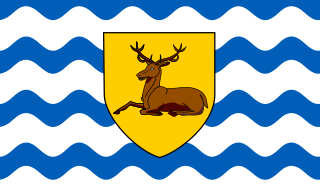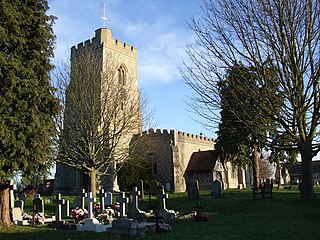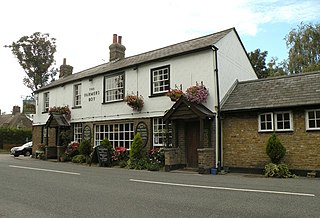
The Kingdom of the East Saxons, referred to as the Kingdom of Essex, was one of the seven traditional kingdoms of the Anglo-Saxon Heptarchy. It was founded in the 6th century and covered the territory later occupied by the counties of Essex, Middlesex, much of Hertfordshire and west Kent. The last king of Essex was Sigered of Essex and in 825, he ceded the kingdom to Ecgberht, King of Wessex.

Hertfordshire is one of the home counties in southern England. It is bordered by Bedfordshire and Cambridgeshire to the north, Essex to the east, Greater London to the south, and Buckinghamshire to the west. For government statistical purposes, it is placed in the East of England region. It covers 634.366 square miles (1,643.00 km2). It derives its name from a hart (stag) and a ford, used as the components of the county's coat of arms and of the flag. Hertfordshire County Council is based in Hertford, once the main market town.

Middlesex is a historic county in southeast England. Its area is almost entirely within the wider urbanised area of London and mostly within the ceremonial county of Greater London, with small sections in neighbouring ceremonial counties.

The home counties are the counties of England that surround London. The counties are not precisely defined but Buckinghamshire and Surrey are usually included in definitions and Berkshire, Essex, Hertfordshire and Kent are also often included. Other counties further from London — such as Bedfordshire, Cambridgeshire, Hampshire and Oxfordshire and Sussex — are not normally regarded as home counties, although on occasion may be thought of as such due to their proximity to London and their connection to the London regional economy.

Bishop's Stortford is a historic market town in Hertfordshire, England, just west of the M11 motorway on the county boundary with Essex, 27 miles (43 km) north-east of central London, and 35 miles (56 km) by rail from Liverpool Street station. Bishop's Stortford had an estimated population of 40,815 in 2019.

Marsworth is a village and a civil parish within the unitary authority area of Buckinghamshire, England. It is about 2 miles (3.2 km) north of Tring, Hertfordshire and 6 miles (9.7 km) east of Aylesbury.

East Hertfordshire is a local government district in Hertfordshire, England. Its council is based in Hertford, the county town of Hertfordshire. The largest town in the district is Bishop's Stortford, and the other main towns are Ware, Buntingford and Sawbridgeworth. At the 2011 Census, the population of the district was 137,687.

Sawbridgeworth is a town and civil parish in Hertfordshire, England, close to the border with Essex. It is 12 miles (19 km) east of Hertford and 9 miles (14 km) north of Epping. It is the northernmost part of the Greater London Built-up Area.

The Rodings are a group of eight villages in the upper part of the River Roding and the west of Essex, England, the largest group in the country to bear a common name. The Rodings do not lie within a single district in the county; they are arranged around the tripoint of the administrative areas of Chelmsford, Uttlesford and Epping Forest. An alternative arcane name, linked to the Middle English Essex dialect, was The Roothings.

Hadham Rural District was a rural district in Hertfordshire, England from 1894 to 1935, covering an area in the east of the county.

Braughing was a rural district in Hertfordshire, England from 1935 to 1974.

Stane Street is a 39 mi (63 km) Roman road that runs from Ermine Street at Braughing, Hertfordshire to Colchester in Essex.

Braughing is a village and civil parish, between the rivers Quin and Rib, in the non-metropolitan district of East Hertfordshire, part of the English county of Hertfordshire. Braughing gave its name to a county division in Hertfordshire, known as a "hundred". This was a rural district from 1935 to 1974. The population at the 2011 Census was 1,203. This includes Bozen Green, Braughing Friars and Brent Pelham.

Brickendon is a village in the civil parish of Brickendon Liberty in the district of East Hertfordshire about 3 miles (4.8 km) south of the county town Hertford, and is served by Bayford railway station.
Hormead is a civil parish in Hertfordshire, England. It comprises the villages of Great Hormead and Little Hormead and the hamlet of Hare Street and lies in the East Hertfordshire district. Hare Street House is located within Hare Street. In 2011 it had a population of 743.

Essex is a county in the East of England. One of the home counties, it borders Suffolk and Cambridgeshire to the north, the North Sea to the east, Hertfordshire to the west, Kent across the estuary of the River Thames to the south and Greater London to the south and south-west. The county town is Chelmsford, which remains the only city in the ceremonial county until Southend-on-Sea is formally accorded city status. For the purposes of government statistics, Essex is placed in the East of England region.
Regiones or provinciae,(singular: provincia), also referred to by historians as small shires or early folk territories, were early territorial divisions of Anglo-Saxon England, referred to in sources such as Anglo-Saxon charters and the writings of Bede. They are likely to have originated in the years before 600, and most evidence for them occurs in sources from or about the 7th century.
The Brahhingas or Brahingas were a tribe or clan of Anglo-Saxon England whose territory was centred on the settlement of Braughing in modern-day Hertfordshire. The name of the tribe means "the people of Brahha", with Brahha likely to have been either a leader of the tribe or a real or mythical ancestor.

Edwinstree was a judicial and taxation subdivision of Hertfordshire, in the east of the county, that existed from the 10th to the 19th century.















